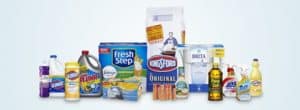Clorox (NYSE:CLX) has managed to increase its dividend every year since 1977, and this past February, the company upped it again. The consistent payout increases have made Clorox a dividend aristocrat and an important part of many income investors’ portfolios.
Dividend-payers tend to fare well during economic downturns and volatile markets, making them a perfect companion for long-term investing. And Clorox management is focused on shareholder returns. As CFO Steve Robs said, “Consistent with our disciplined approach to cash allocation, shareholders remain a priority, and we’re pleased to be in a position to continue to return excess cash to them.”

How does Clorox compare to its peers?
With a current yield of approximately 3%, Clorox fares well compared to its rivals in the consumer goods industry, including Church & Dwight, Colgate-Palmolive, and Kimberly Clark.
Of course, when it comes to evaluating dividend stocks, we don’t just look at the yield, which only tells one part of the story. What we want to consider is the dividend payout ratio, which measures the sustainability of the dividend relative to a company’s earnings.
Clorox has a payout ratio of 63%, which means that around two-thirds of its earnings are paid out as dividends. For a mature company, it’s a balancing act between generating growth through reinvestment and returning cash to shareholders.
This directly ties into its long-term 2020 financial strategy which aims to deliver up to 5% top-line growth and generate free cash flow of between 11% and 13% as a percentage of sales. A strong focus on free cash flow is a good sign that the company is keeping tabs on its dividend strategy. Clorox also recently announced a new share repurchase program of up to $2 billion, which is aimed at further increasing the total shareholder return.
A track record of market outperformance?
While the company has increased its dividend every year for over four decades and delivered quarterly increases of about 5% since 2015, when we look at the overall shareholder return (which also takes price appreciation into account), Clorox is currently underperforming the market. The company is not alone in this position, as the entire consumer goods sector is struggling from cost pressures and other headwinds.

What does this mean going forward?
There’s little doubt the dividend is safe, and if you’re diversifying your portfolio with consumer goods companies, Clorox should not be overlooked by long-term investors. Its yield compares favorably to peers and easily tops the broad market.
But as a leader in an industry going through major changes, the real challenges for investors to consider are its ability to manage rising costs, connect with consumers, and target the right categories (both organically or with acquisitions).


